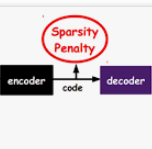Sparse representations of images are useful in many computer vision applications. Sparse coding with an $l_1$ penalty and a learned linear dictionary requires regularization of the dictionary to prevent a collapse in the $l_1$ norms of the codes. Typically, this regularization entails bounding the Euclidean norms of the dictionary's elements. In this work, we propose a novel sparse coding protocol which prevents a collapse in the codes without the need to regularize the decoder. Our method regularizes the codes directly so that each latent code component has variance greater than a fixed threshold over a set of sparse representations for a given set of inputs. Furthermore, we explore ways to effectively train sparse coding systems with multi-layer decoders since they can model more complex relationships than linear dictionaries. In our experiments with MNIST and natural image patches, we show that decoders learned with our approach have interpretable features both in the linear and multi-layer case. Moreover, we show that sparse autoencoders with multi-layer decoders trained using our variance regularization method produce higher quality reconstructions with sparser representations when compared to autoencoders with linear dictionaries. Additionally, sparse representations obtained with our variance regularization approach are useful in the downstream tasks of denoising and classification in the low-data regime.
翻译:图像的偏差描述在许多计算机视觉应用中是有用的。 使用1美元罚款和精通的线性字典的粗化编码要求字典的正规化, 以防止代码代码值的1美元标准崩溃。 通常, 这种正规化需要将词典元素的Euclidean规范捆绑起来。 在这项工作中, 我们提议了一个新颖的稀疏编码协议, 防止代码值的崩溃, 而不需要对解码器进行正规化。 我们的方法直接规范代码, 使每个潜在代码元件在一组特定投入的稀疏表达方法上的差异大于固定的门槛值。 此外, 我们探索了如何有效地培训多层解码器的稀疏编码系统, 因为它们可以模拟比线性字典更复杂的关系。 在我们对MNIST和自然图像补丁的实验中, 我们发现, 与我们的方法学得的解码器在线性和多层中都有可解释的特征。 此外, 我们显示, 使用差异规范法化方法训练多层解码器的稀释器的稀疏的重新进行质量的重建,, 与我们获得的分解的解式的解析变的系统化方法在低的分类化方法中, 。



